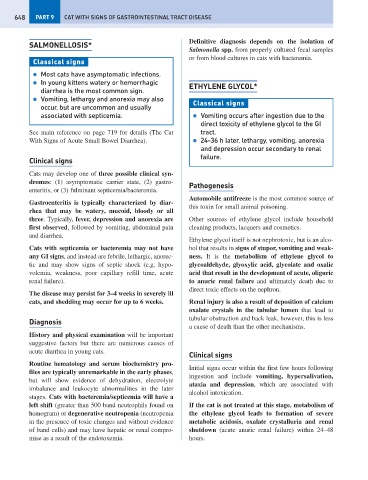Page 656 - Problem-Based Feline Medicine
P. 656
648 PART 9 CAT WITH SIGNS OF GASTROINTESTINAL TRACT DISEASE
Definitive diagnosis depends on the isolation of
SALMONELLOSIS*
Salmonella spp. from properly cultured fecal samples
or from blood cultures in cats with bacteremia.
Classical signs
● Most cats have asymptomatic infections.
● In young kittens watery or hemorrhagic ETHYLENE GLYCOL*
diarrhea is the most common sign.
● Vomiting, lethargy and anorexia may also
Classical signs
occur, but are uncommon and usually
associated with septicemia. ● Vomiting occurs after ingestion due to the
direct toxicity of ethylene glycol to the GI
See main reference on page 719 for details (The Cat tract.
With Signs of Acute Small Bowel Diarrhea). ● 24–36 h later, lethargy, vomiting, anorexia
and depression occur secondary to renal
failure.
Clinical signs
Cats may develop one of three possible clinical syn-
dromes: (1) asymptomatic carrier state, (2) gastro-
Pathogenesis
enteritis, or (3) fulminant septicemia/bacteremia.
Automobile antifreeze is the most common source of
Gastroenteritis is typically characterized by diar-
this toxin for small animal poisoning.
rhea that may be watery, mucoid, bloody or all
three. Typically, fever, depression and anorexia are Other sources of ethylene glycol include household
first observed, followed by vomiting, abdominal pain cleaning products, lacquers and cosmetics.
and diarrhea.
Ethylene glycol itself is not nephrotoxic, but is an alco-
Cats with septicemia or bacteremia may not have hol that results in signs of stupor, vomiting and weak-
any GI signs, and instead are febrile, lethargic, anorec- ness. It is the metabolism of ethylene glycol to
tic and may show signs of septic shock (e.g. hypo- glycoaldehyde, glyoxylic acid, glycolate and oxalic
volemia, weakness, poor capillary refill time, acute acid that result in the development of acute, oliguric
renal failure). to anuric renal failure and ultimately death due to
direct toxic effects on the nephron.
The disease may persist for 3–4 weeks in severely ill
cats, and shedding may occur for up to 6 weeks. Renal injury is also a result of deposition of calcium
oxalate crystals in the tubular lumen that lead to
tubular obstruction and back leak, however, this is less
Diagnosis
a cause of death than the other mechanisms.
History and physical examination will be important
suggestive factors but there are numerous causes of
acute diarrhea in young cats.
Clinical signs
Routine hematology and serum biochemistry pro-
Initial signs occur within the first few hours following
files are typically unremarkable in the early phases,
ingestion and include vomiting, hypersalivation,
but will show evidence of dehydration, electrolyte
ataxia and depression, which are associated with
imbalance and leukocyte abnormalities in the later
alcohol intoxication.
stages. Cats with bacteremia/septicemia will have a
left shift (greater than 500 band neutrophils found on If the cat is not treated at this stage, metabolism of
hemogram) or degenerative neutropenia (neutropenia the ethylene glycol leads to formation of severe
in the presence of toxic changes and without evidence metabolic acidosis, oxalate crystalluria and renal
of band cells) and may have hepatic or renal compro- shutdown (acute anuric renal failure) within 24–48
mise as a result of the endotoxemia. hours.

